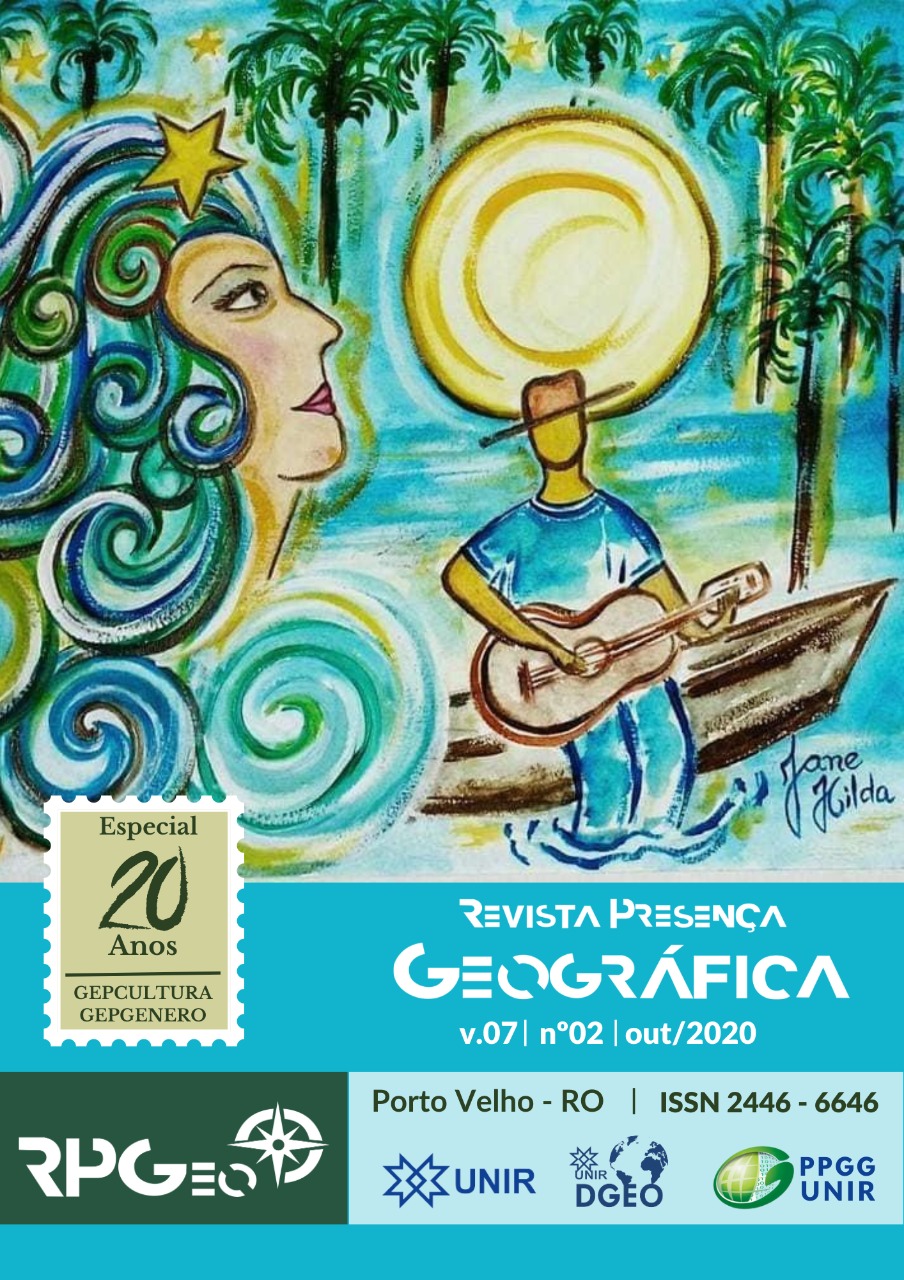The two bands of the gourd: immaterial cultural heritage of Brazil
DOI:
https://doi.org/10.36026/rpgeo.v7i2.5630Keywords:
Embroidered gourd, Painted gourd, Cultural Heritage, Crafts, Amazon.Abstract
The theme of this article “The two bands of the gourd: immaterial cultural heritage of Brazil” is the result of the rich experience and unfolding of the researches entitled “The gourds embroidered by Aritapera: knowledge, knowledge and art, and “Painting gourds, painting lives: tradition and art by the Camargo Fona family. Embroidered and painted gourds constitute an artisanal craft of indigenous origin, and its importance consists of the relationships, contexts and ways of life that involve the riverside and urban universe, their relationship with the Amazonian space, the use of natural resources and their maintenance for sustainable production of embroidered and painted gourds. All of these elements are of great interest to Humanistic Cultural Geography, as contemporary geographic studies have broadened their field of research by seeking to understand the spatial condition of human relations, as well as the symbolic dimension of culture. The aforementioned article has the challenge of exposing a theme little known in the academic context, and it is justified for enabling the debate and giving rise to new studies, by unveiling to society, the universe of Santarém's handicrafts. In this way, our objective is to understand the importance of recognizing and patrimonializing the way of knowing how to make handicrafts in gourds with regard to the two segments – embroidered and painted, in the municipality of Santarém-Pará.Downloads
References
ANDRADE, Mario de. A cuia de Santarém. In: Suplemento Literário de Diretrizes, Rio de Janeiro, Ano 2, nº 20, nov. 1939. (Série Matérias extraídas de periódicos, Arquivo Mário de Andrade, IEB/USP).
AMORIM, Antonia Terezinha dos Santos. Santarém: Uma síntese histórica.
Canoas: Ed. ULBRA, 1999.
BRASIL. Constituição da República Federativa do Brasil. Brasília: DF, 1988.
Disponível em: http://www.planalto.gov.br/ccivil_03/Constituicao/Constituicao.htm.
Acesso em: 20 de maio de 2020.
CAMARGO FONA, Angelsea A. Lobato. Pintando cuias, pintando vidas: Tradição e arte pelas mãos da família Camargo Fona 2015. 284 f. Dissertação, Mestrado em
Geografia, Programa de Pós Graduação Mestrado, Universidade Federal de Rondônia.
Porto Velho, 2016.
CARVALHO, Luciana. O artesanato de cuias em perspectiva – Santarém. Rio de
Janeiro: IPHAM, CNFCP, 2011.
CARVALHO, Luciana; SANTOS, A.M. Terra água, mulheres e cuias: Aritapera,
Santarém, Pará, Amazônia. Belém: Prodetur, 2012.
Centro Nacional de Folclore e Cultura Popular. Almanaque Pitinga. Organização de Aída Bezerra e Renato Costa. -- Rio de Janeiro: IPHAN, CNFCP, 2011.
CLAVAL, Paul. A Geografia Cultural. Tradução: Luíz Fugazzola Pimenta e
Margareth de castro Afeche Pimenta. 2ª Ed. Florianópolis: Ed. da UFSC, 2001.
FERREIRA, Alexandre Rodrigues. Memórias sobre as cuyas (1786). Revista Nacional
de Educação. Março de 1933, nº6, p. 58-63.
FONSECA, Wilson. Meu Baú Mocorongo. V.2. Belém: SECULT/SEDUC,
-a.
FONSECA, Wilson. Raimundo Fona 1893-1941- Obra Musical Remanescente.
Santarém, 2006-b.
GRUNBERG, Evelina. Educação patrimonial: utilização dos bens culturais como recursos educacionais. Cadernos do CEOM. Ano 14 nº12. UNOESC, Chapecó, jun. 2000.
IPHAN. Modos de fazer cuias do Baixo Amazonas. Disponível em
http://portal.iphan.gov.br/pagina/detalhes/1055/. Acesso em 10 de julho de 2020.
Instituto do Patrimônio Histórico e Artístico Nacional (IPHAN).
Patrimônio Cultural Imaterial : para saber mais / Instituto do Patrimônio Histórico e Artístico Nacional ; texto e revisão de, Natália Guerra Brayner. -- 3. ed. -- Brasília, DF: Iphan, 2012.
LERY, Jean de. Viagem à Terra do Brasil. Belo Horizonte: Itatiaia, 1980
LODY, Raul. Brasil bom de boca: temas da antropologia da alimentação.
São Paulo: Editora SENAC São Paulo, 2008.
NAÇÕES UNIDAS. Declaração Universal dos Direitos Humanos. Disponível em:
https://nacoesunidas.org/wp-content/uploads/2018/10/DUDH.pdf. Acesso em: 16 mai. 2020.
SANTOS, Antônio. Aritapera: Uma comunidade de pequenos produtores na várzea
amazônica (Santarém – PA). Boletim do Museu Paraense Emilio Goeldi, Belém: vol.
, nº 83 maio, 1982.
SECRETARIA MUNICIPAL DE TURISMO – SEMTUR. Inventário da Oferta e
Infra- Estrutura Turística de Santarém. Divisão de Planejamento Turístico:
Atualização, 2010.
SOUSA, Ádria Fabíola Pinheiro de; SILVA, Josué da Costa. Práticas de Cura pelas Mãos de Dona Lenil, Sabedora da Comunidade Enseada do Aritapera, Várzea de Santarém, Pará. Revista Latino Americana de Geografia e Gênero, v. 9, n. 1, p. 120137, 2018.
TUAN, Yu-Fu. Espaço e lugar. A perspectiva da experiência. Londrina: Eduel, 2013.
Published
Issue
Section
License
This work is licensed under Creative Commons Attribution-NonCommercial-NoDerivatives 4.0 Internacional license.
Authors who publish in this journal agree to the following terms:
- Authors retain the copyright and grant the journal the right to first publication, with the work simultane ously licensed under Creative Commons Attribution-NonCommercial-NoDerivatives 4.0 Internacional License that allows the sharing of the work with acknowledgment of authorship and initial publication in this journal.
- Authors are authorized to assume additional contracts separately, for non-exclusive distribution of the version of the work published in this journal (ex, publishing in institutional repository or as a book chapter), with acknowledgment of authorship and initial publication in this journal.
- Authors are allowed and encouraged to publish and distribute their work online (ex.: in institutional repositories or on their personal page) at any point before or during the editorial process, as this can generate productive changes, as well as increase the impact and the citation of the published work (See The Free Acess Policy).












